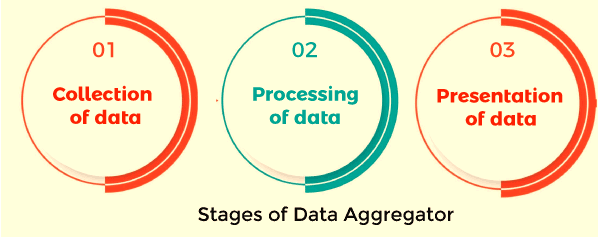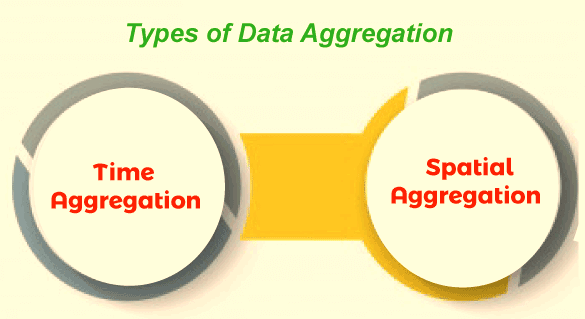Aggregation in data miningData aggregation refers to a process of collecting information from different sources and presenting it in a summarized format so that business analysts can perform statistical analyses of business schemes. The collected information may be gathered from various data sources to summarize these data sources into a draft for data analysis. This step is the major step taken by any business organization because the accuracy of insights from data analysis majorly depends on the quality of data they use. It is very necessary to collect quality content in huge amounts so that they can create relevant outcomes. Data aggregation plays a vital role in finance, product, operations, and marketing strategies in any business organization. Aggregated data is present in the data warehouse that can enable one to solve various issues, which helps solve queries from data sets. In this article, we will discuss the aggregation in data mining, their process, its applications, along with examples. How does data aggregation work?Data aggregation is needed if a dataset has useless information that can not be used for analysis. In data aggregation, the datasets are summarized into significant information, which helps attain desirable outcomes and increases the user experience. Data aggregation provides accurate measurements such as sum, average, and count. The collected, summarized data helps the business analysts to perform the demographic study of customers and their behavior. Aggregated data help in determining significant information about a specific group after they submit their reports. With the help of data aggregation, we can also calculate the count of non-numeric data. Generally, data aggregation is done for data sets, not for individual data. Example of data aggregationOrganizations usually gather information about their online customers and website visitors. Here, the data aggregation involves statistics on customers' demographic and behavior matrices such as different age groups of customers and the total number of transactions. The marketing team does the data aggregation, which helps them personalize messaging, offers, and more in the user's digital experiences with the brand. It also helps the product management team of any organization to know which products generate more revenue and which are not. The aggregated data is also used by the financial and company executive, which helps them select how to allocate budget towards marketing or product development strategies. It helps determine the average age of customers buying a specific product, which helps the business management team find the target age group for that specific product. In data aggregation usually prefer to calculate the average age of customers rather than individual customers. Calculating the value of voter turnout in a country or state. It is achieved by counting the total number of votes of a candidate in a specific region instead of counting the individual records of the voter. Data aggregatorsData aggregators refer to a system used in data mining to collect data from various sources, then process the data and extract them into useful information into a draft. They play a vital role in enhancing the customer data by acting as an agent. It also helps in the query and delivery procedure where the customer requests data instances about a specific product. The marketing team does the data aggregation, which helps them personalize messaging, offers, and more in the user's digital experiences with the brand. It also helps the product management team of any organization to know which products generate more revenue and which are not. The aggregated data is also used by the financial and company executive, which helps them select how to allocate budget towards marketing or product development strategies. Working of data aggregatorsThe working of data aggregators can be performed in three stages

Collection of data As the name suggests, the collection of data means gathering data from different sources. The data can be extracted using the internet of things (IoT), such as
Processing of data Once data is collected, the data aggregator determines the atomic data and aggregates it. In the data processing technique, data aggregators use numerous algorithms form the AI or ML techniques, and it also utilizes statical methodology to process it like the predictive analysis. Presentation of data In this step, the gathered information will be summarized, providing a desirable statistical output with accurate data. Choice of automated or manual data aggregators Data aggregation can also be applied manually. When someone starts, any startup can choose a manual aggregator by using excel sheets and creating charts to manage the performance, marketing and budget. Data aggregation is a well-established organization that uses a middleware, typically third-party software, to implement the data automatically using various marketing tools. But in the case of huge datasets, a data aggregator system is needed because it provides accurate outcomes. Types of Data AggregationData Aggregation can be divided into two different types

Time Aggregation Time aggregation provides the data point for an individual resource for a defined period. Spatial aggregation Spatial aggregation provides the data point for various groups of resources for a defined period. Time intervals for the data aggregation processReporting period Reporting period refers to the period in which the information is gathered for the presentation. It can either be a data point aggregated process or raw data. For example, the information is gathered and processed into a summarized format in a specified period of one day from a network device. Therefore, the reporting period will be one day. Polling period The polling period refers to the frequency in which resources are sampled for data. For example, if the group of resources can be polled every 5 minutes, it means data points for each resource will be generated every 5 minutes. Polling and Granularity come under spatial aggregation. Granularity Granularity refers to a period in which information is gathered for aggregation. For example, to calculate the sum of data points for a particular resource gathered over a period of 6 minutes. Hence, the granularity will be 6 minutes. The value of granularity can vary form minute to month, relying upon the reporting time, and it plays a vital role in granularity. Application of data aggregationThese are some important applications of data aggregation Data aggregation in the financial and investing sectors The financial and investment sector are mostly basing their recommendations on alternative data. A huge portion of that data comes from the news since investors must stay updated on the latest financial and industrial trends. So, the financial institution can use data aggregation to collect headlines and related news and use that data for predictive analytics. The market information related to industrial and financial sectors is available on the news websites without any cost, but it is spread across multiple websites. Gathering data from each website manually is quite difficult and may give unreliable data sets due to missing data. Data aggregation in the retail industry Data aggregation plays a vital role in retail and eCommerce industries, for example, competitive price monitoring. Competitive price monitoring is a useful tool for marketers to succeed in the eCommerce and retail sector. Organizations need to know what they are up against. So, they are more inclined towards gathering information about their competitor's product offerings, promotions, and prices. The data relating to the competitor's website are pulled from the other sites their products are listed on. The data must be aggregated from every relevant source to get the correct information on the competitive website. Data aggregation in the travel industry Data aggregation has huge applications in the travel industry, including competitive price monitoring, gaining market insights, customers behavior analysis, and capturing images and descriptions for the services on their online traveling sites. Travel industries need to keep attention to every changing traveling cost and property availability. They also have to pay attention to trending destinations and target audiences with their tempting offers. The data related to the travel industries spread across multiple places on the internet; gathering data manually is quite a tough task. Here, the data extraction and aggregation service come in.
Next TopicRegression in data mining
|
 For Videos Join Our Youtube Channel: Join Now
For Videos Join Our Youtube Channel: Join Now
Feedback
- Send your Feedback to [email protected]
Help Others, Please Share










